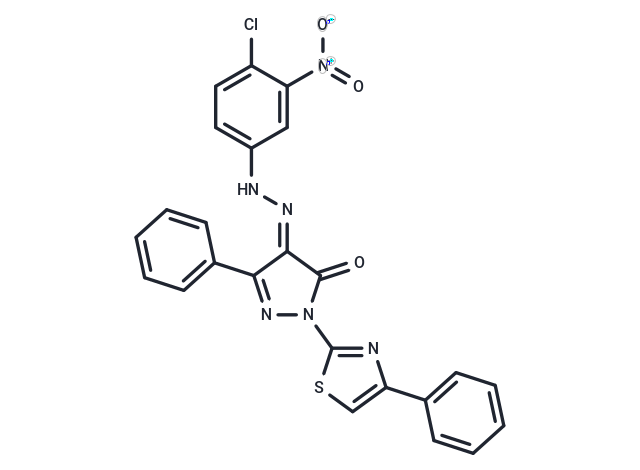Shopping Cart
- Remove All
 Your shopping cart is currently empty
Your shopping cart is currently empty

C 87 is a small-molecule TNF-α inhibitor. C 87 directly binds to TNFα, potently inhibits TNF-α-induced cytotoxicity (IC50 = 8.73 μM), and effectively blocks TNF-α-triggered signaling activities.

| Pack Size | Price | Availability | Quantity |
|---|---|---|---|
| 2 mg | $39 | In Stock | |
| 5 mg | $64 | In Stock | |
| 10 mg | $97 | In Stock | |
| 25 mg | $198 | In Stock | |
| 50 mg | Inquiry | In Stock |
| Description | C 87 is a small-molecule TNF-α inhibitor. C 87 directly binds to TNFα, potently inhibits TNF-α-induced cytotoxicity (IC50 = 8.73 μM), and effectively blocks TNF-α-triggered signaling activities. |
| Targets&IC50 | TNF-α induced cytotoxicity:8.73 μM |
| In vitro | C 87 reduces the activity of c-Jun N-terminal kinase (JNK) in L929 cells. C 87 prevents the degradation of IκBα in cells treated with TNF-α and potently blocks multiple signaling transduction pathways and downstream target gene activation triggered by TNF-α. C 87 exhibits good solubility and consistent dose-dependent functions in vitro. C 87 completely blocks the TNFα-induced activation of caspase-3 and caspase-8[1]. |
| In vivo | In mice, the level of alanine transaminase and aspartate transaminase is consistently reduced. C 87 markedly reduces injuries to the liver and improves animal survival. C 87 injection delays the incidence of death and increases the survival rate by two fo |
| Molecular Weight | 502.93 |
| Formula | C24H15ClN6O3S |
| Cas No. | 332420-90-3 |
| Smiles | [O-][N+](=O)c1cc(N\N=C2\C(=O)N(N=C2c2ccccc2)c2nc(cs2)-c2ccccc2)ccc1Cl |
| Relative Density. | 1.51 g/cm3 (Predicted) |
| Storage | Powder: -20°C for 3 years | In solvent: -80°C for 1 year | Shipping with blue ice. | |||||||||||||||
| Solubility Information | DMSO: 5 mg/mL (9.94 mM), Sonication is recommended. | |||||||||||||||
Solution Preparation Table | ||||||||||||||||
DMSO
| ||||||||||||||||

Copyright © 2015-2025 TargetMol Chemicals Inc. All Rights Reserved.